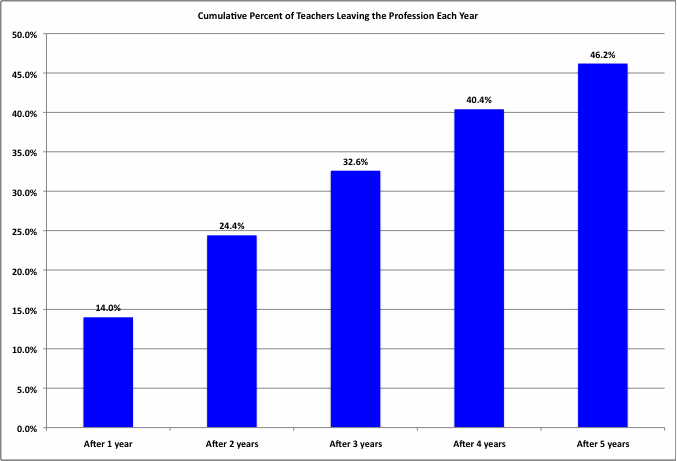What is the turnover for new teachers over time?
Why is this question important? Teacher turnover is an enormous cost for education systems, both in terms of student performance and dollars. High turnover results in increased numbers of inexperienced teachers, a loss of trained teachers, and a cost in dollars for recruitment, hiring, and training new teachers. New teachers seem to be particularly "at risk" for higher turnover during the beginning of their careers.
See further discussion below.

Source: Is There Really a Teacher Shortage?
Results: The data suggests that new teachers are at risk of high turnover, with almost half of the leaving the profession after five years.
Implications: Efforts at improving teacher retention have not been successful overall. This trend represents a major obstacle to long term school improvement.
Author(s): Richard Ingersoll, University of Pennsylvania
Publisher: Center for the Study of Teaching and Policy
Study Description: Ingersoll completed the analysis using data from the National Center for Education Statistics (NCES) surveys concerning schools and school personnel. The initial surveys were completed in the nid 1980's. In 1985, NCES undertook a critical review of its elementary and secondary school data system, identifying gaps in content and in design. As a result of this review, NCES redesigned the SASS survey system to emphasize teacher demand and shortage, teacher and administrator characteristics, school programs, and general conditions in schools. SASS also collects data on many other topics, including principals' and teachers' perceptions of school climate and problems in their schools; teacher compensation; district hiring practices and basic characteristics of the student population. In 1999-2000, public charter schools were also included in the sample. For the 2003–04 SASS, a sample of public charter schools are included in the sample as part of the public school questionnaire. http://nces.ed.gov/Surveys/SASS/index.asp
Citation:
Ingersoll, R. (2003). Is there really a teacher shortage? Center for the Study of Teaching and Policy, University of Washington
